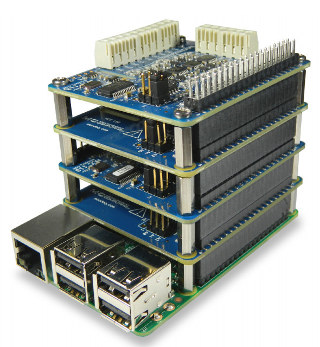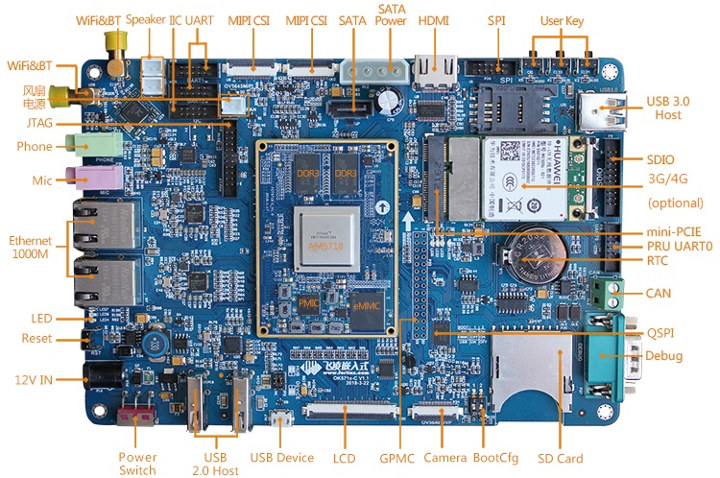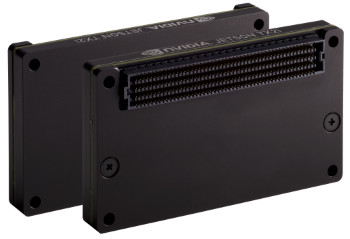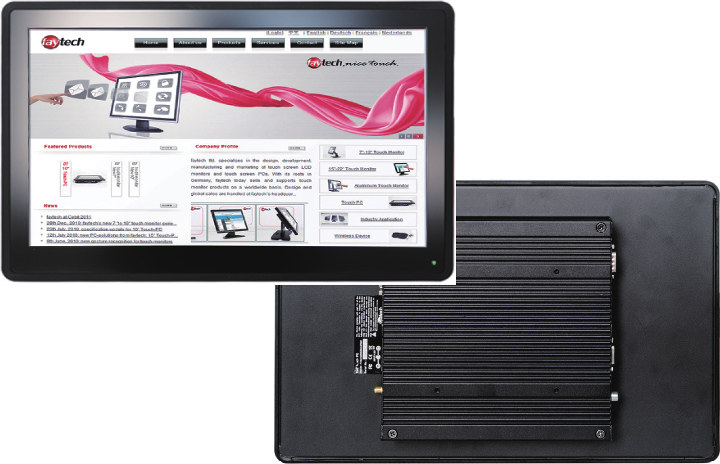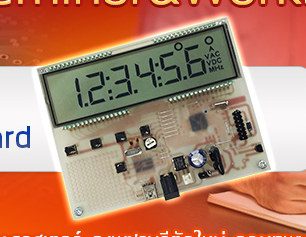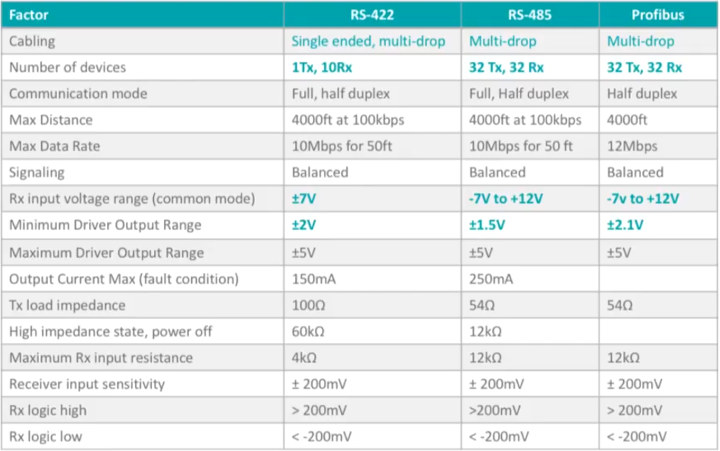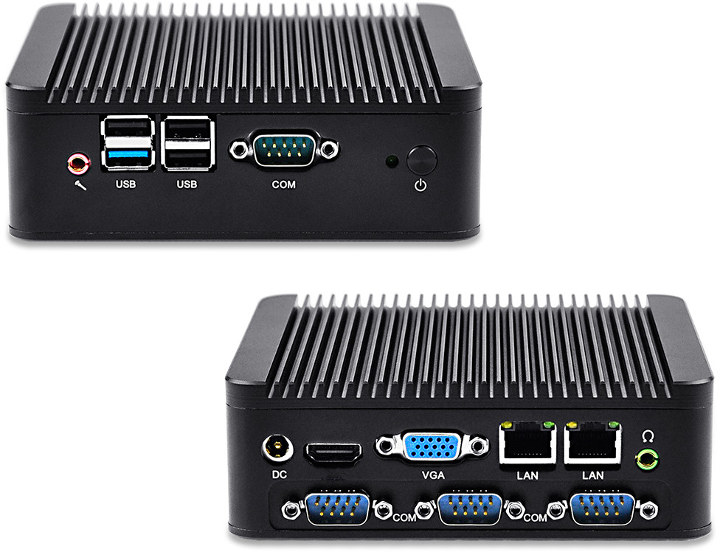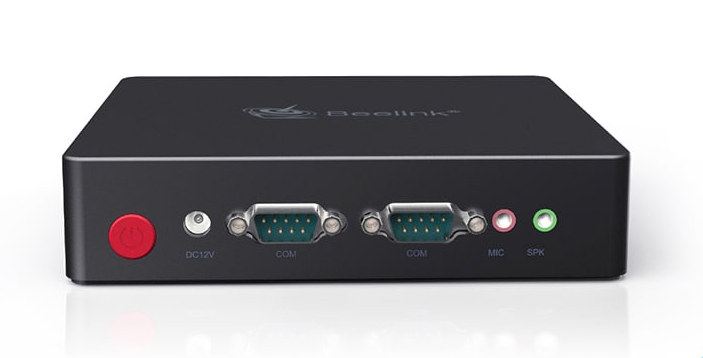Measurement Computing Corp. (MCC) has recently introduced their MCC 118 DAQ HAT for Raspberry Pi which includes 8 analog inputs for voltage measurements between +/- 10V at a 100kS/s data rate. You can also perform data acquisition on up to 64 channels by stacking up to 8 MCC-118 DAQ HATs on top of a single Raspberry Pi board. The maximum throughput is limited to 320 kS/s. MCC 118 DAQ HAT key features & specifications: 8x 12-bit voltage inputs 100 kS/s max sample rate (320 kS/s aggregate for stacked boards) ±10 V input range Onboard sample buffers allow for high-speed acquisition External scan clock I/O External digital trigger input Screw terminal connections Up to eight MCC HATs are stackable on top of a Raspberry Pi board The data acquisition / data logger systems based on the add-on board would run Raspbian (Lite) on the Raspberry Pi board, as well as a […]
Forlinx OK5718-C Development Board is Powered by TI AM5718 Cortex-A15/M4 processor
Forlinx Embedded Technology (Forlinx) has just launched a new development board for indsutrial applications with audio and video processing requirements. OK5718-C development board features Texas Instruments AM5718 Sitara SoC with a single Arm Cortex-A15 core, two real-time Cortex-M4 cores, a dual PRU, and a TI C66x DSP core. OK5718-C development board consists of a carrier board and FET5718-C SoM with the following specifications: FET5718-C System-on-Module SoC – TI AM5718 Sitara Arm Cortex-A15 processor @ up to 1.5GHz, C66x DSP @ 750MHz, dual-core Arm Cortex-M4 @ 213MHz, dual core PRU @ 200MHz, PowerVR SGX544 3D GPU, Vivante GC320 2D GPU, IVA-HD video accelerator subsystem (H.264, MPEG4, MPEG2, VC1) System Memory – 1GB DDR3L Storage – 8GB eMMC flash Board-to-board connectors for interface with baseboard – 320–pin exposing USB 3.0, PCIe 3.0, HDMI 1.4a, LCD RGB, 10x UART, 1x QSPI, 2x CAN, 2x Gigabit Ethernet, etc… PMU – TI TPS659162RGZR Supply Voltage – […]
NVIDIA Jetson TX2i Module is Designed for Industrial Environments
NVIDIA Jetson TX2 “Artificial Intelligence Computer” module was announced in March 2017 with a Tegra X2 hexa-core processor, a 256-core Pascal GPU, 8GB RAM, 32GB storage, and support for 4K 60 fps encoding and decoding. But it turns out NVIDIA announced an rugged version of the module dubbed Jetson TX2i designed for reliable operation in harsh industrial environments in March of this year. NVIDIA Jetson TX2 and TX2i are pin-to-pin compatible, and can run the same software, but TX2i has been designed and tested for rougher conditions. Feature Jetson TX2 Jetson TX2i Shock 140G, 2ms 140G, 2ms Vibration 10Hz ~200Hz, 1g & 2g RMS Random: 5g RMS 10 to 500Hz Sinusoidal: 5g RMS 10 to 500Hz Temp Range -25°C – 80°C -40°C – 85°C Humidity 85°C / 85% RH, 168 hours -10°C to 65°C / 95% RH, 240 hours Operating Life 5 Years (GB at 35C: MTBF=1,747,520 hours GF at […]
Faytech 15″ to 17″ Capacitive Touch PCs Ship with Ubuntu 16.04
Although many can support Ubuntu or other Linux distributions, most Intel based products ship with some version of Windows by default, and the end users may have to install Linux by themselves. While watching a Computex 2018 video on Armdevices.net, I found out FayTech, a company specializing in the design, development, manufacturing and marketing of touchscreen monitors & PCs, showed a 15″ Touch PC powered by an Intel Celeron J1900 “Bay Trail” processor and running Ubuntu 16.04 LTS. So I had a look on the company website, and the 15″ capacitive touch PC (FT15J1900W4G64GCAP) showcased in the video – embedded at the end of this article – comes with the following key features and specifications: SoC – Intel Celeron J1900 quad core processor @ 2.0 / 2.4 GHz with Intel HD Graphics; 10W TDP System Memory – 4GB DDR3L-1333 via 1x SO-DIMM slot, expandable to 8GB Storage – Industrial 64GB […]
LAPIS ML62Q1622 is a General Purpose 16-bit MCU with an LCD Driver
So this morning I received an email about some seminar & workshop about LAPIS microcontroller, including a free ML62Q1622 evaluation board. OK, good. But wait. Who is LAPIS? I have certainly never seen any projects with Lapis MCUs, and probably have never heard of them. It turns out OKI SEMICONDUCTOR Co.,Ltd. established in 2008 from a spin-off of Oki Electric Industry Co., Ltd, changed the company name in to LAPIS Semiconductor Co.,Ltd in 2011. LAPIS is also part of ROHM Semiconductor group. Anyway, it was a good opportunity to find out more about ML62Q1622 micro-controller, and related evaluation boards & tools. Lapis Semi ML62Q1622 is part of ML62Q1600 group of 16-bit microcontrollers whose block diagram is shown above. ML62Q1622 MCU key features & specifications: CPU – 16-bit RISC CPU (CPU name: nX-U16/100) clocked @ up to 32 MHz Coprocessor for multiplication and division Program Memory – 64Kbyte Data Memory – […]
Differences Between RS232, RS422 and RS485 (Video)
RS232, RS422, and RS485 are pretty old serial communication interfaces, and I was not even born when RS232 was specified in 1962, but there are still commonly used today in various applications such a points-of-sales, multi-meters, industrial equipment like PLC or HMI, as well as medical devices. Maxim Integrated shared a video – embedded at the end of this article – on social networks today explaining the fundamentals of serial transmitter devices and the differences between RS232, RS422, RS485, and Profibus. The video goes into more details with a glossary of terms, discussion of cable length and bitrate, hand-shaking, and auto-shutdown, but I’ll provide a quick summary below: RS232 supports one transmitter and one receiver, and operates between -15 and +15V (with input tolerance of up to -/+ 25V). A logic zero is between +3 and +15V and a logic one between -15 and -3V on the receiver side RS422 […]
Qotom Q180P/Q190P Mini PC Comes with Four RS-232 DB9 Connectors
Earlier today, I covered Beelink KT03 “Client Computer”, an Apollo Lake barebone mini PC with two COM ports . But as you must already know, people on the Internet are hard to please, so some readers may have thought “meh, no Thunderbolt”, “lol, Apollo Lake… so old”, “where’s the NVMe socket?”. I won’t be addressing those concerns in this post, and instead I will focus on the “meh, only two COM ports, I need four!” crowd. So I went a little web search, and found another low power compact mini PCs with not two, but four COM ports. Qotom Q180P/Q190P are Cherry Trail mini PCs based on Intel Celeron J1800 / J1900 dual/quad core processor respectively. Qotom Q180P/Q190P specifications: SoC (one of the other) Intel Celeron J1800 dual core processor @ 2.41 GHz (base) / (turbo) 2.58 GHz with Intel HD graphics; 10W TDP Intel Celeron J1900 Quad core processor […]
Beelink KT03 Client Computer is a $150 Barebone Mini PC with Two COM Ports
Beelink launched several Apollo Lake mini PCs in the last few years, and despite moving to Intel Gemini Lake family for some of their more recent models such as Beelink S2 or Beelink X45, the company has just launched a new Apollo Lake model. The new Beelink KT03 “client computer” is powered by an Intel Celeron J3455 processor, but differs from other mini PCs from the company, as it is sold barebone without RAM nor storage (nor OS), comes with two DB9 RS-232 connectors, and dual Gigabit Ethernet ports. Beelink KT03 specifications: SoC – Intel Celeron J3455 quad core Apollo Lake processor @ 1.5 GHz / 2.3 GHz (Turbo) with 12 EU Intel HD graphics 500 @ 250/750 MHz; 6W TDP System Memory – 1x SODIMM DDR3L socket, no EEC, 1333/1600/1867 MHz; supports up to 8GB RAM Storage – 64Mbit SPI flash for UEFI/BIOS; support for internal 2.5″ SATA drives, […]


